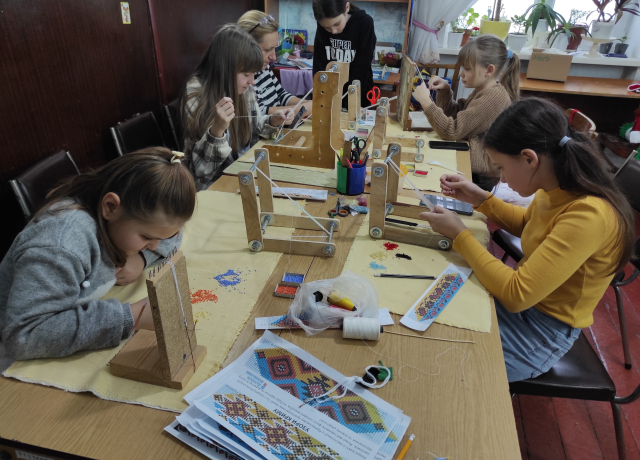European Heritage Days Article:
Revitalizing Traditions: How Youth are Preserving Cultural Heritage
European Heritage Days Article:
Revitalizing Traditions: How Youth are Preserving Cultural Heritage
Photo: Kirovohrad Embroidery - Young European Heritage Makers project, Ukraine (credit, Pobuzhsky Art Center for Children Дні європейської спадщини)
Many other cultural organizations also offer programs and activities to help young people explore, develop, and preserve their cultural heritage. Below are examples of events and initiatives across Europe where young people are actively preserving cultural heritage. These can also serve as inspiration for European Heritage Days organizers.
Europeana Transcribathon
The Europeana Transcribathon initiative is an “online citizen science project” focused on enriching digitized materials. It offers a platform where the public can transcribe, annotate, and geo-reference Europe’s digital cultural heritage from the Europeana Collections. This makes historical documents, like handwritten letters, more accessible and searchable.
The project engages participants through online competitions, with awards for those who transcribe the most within a set time. For example, a recent event focused on making women's stories more visible during Women's History Month. Participants digitized documents such as the diary of 19th-century Polish novelist Narcyza Żmichowska and letters from French soprano Pauline Viardot. The project is also an excellent educational tool for schools and universities, particularly in history, languages, and social studies. In 2017, 50 Culture Studies students from the University of Linz in Austria transcribed World War I diaries, which not only enhanced their history learning but also made these private collections available to the public.
World Heritage Youth Forum
The World Heritage Youth Forum is a key educational activity of UNESCO’s World Heritage Education Programme. It brings young people and heritage experts together to learn about heritage conservation and preservation through cultural exchange. The forum helps participants discover new roles for themselves in the heritage sector.
Each year, a Young Professionals Forum is held in a different host country. Participants meet each other and visit World Heritage sites to learn about heritage management. For example, in 2019, the forum was held in Croatia. Participants engaged in lectures, interactive games, and group work based on local heritage case studies, like Dry Stone Walling and the Venetian Works of Defence. They also spoke with local residents to understand what these aspects of heritage mean to them. The forum resulted in the creation of a network of 28 young heritage professionals who continue to promote and develop the ideas they learned during the event.
Youth festivals across Europe
There are many local and national festivals across Europe aimed at engaging young people in cultural heritage. One of the largest is the Urdd National Eisteddfod in Wales, an annual Welsh language festival of arts and culture. It sees over 15,000 children and young people compete in various categories, from cookery to theatre and dance, welcoming both fluent Welsh speakers and learners.
Other festivals are international, such as the European Youth Music Festival in Belgium. This year, over 91 choirs from 19 countries performed during the festival weekend, participating in workshops, concerts, and a festival parade. Another example is the European Youth Weeks (Europäische Jugendwochen), a youth and folklore festival held at Ludwigstein Castle in Germany. About 200 participants from at least four European countries come together for a week-long event, performing songs and dances from their home countries, and participating in workshops to understand each other's cultures better.
Erasmus+
Erasmus+ is an EU program that supports education, training, youth, and sport, promoting young people's participation in democracy and encouraging green and digital solutions. Many Erasmus+ projects focus on cultural heritage. For example, one project trained young workers in traditional crafts like stonecutting, masonry, and carpentry, which are essential for restoring historic buildings. Another project involved school children from six countries studying the Art Nouveau movement as part of European heritage, including visits to art exhibitions and learning about architecture and filmmaking.
The impact of Erasmus+ is highlighted in participant case studies for the program's 35th anniversary. One participant from the Netherlands shared experiences of discovering local customs through cookery and dance workshops during youth exchanges in Spain, Austria, and France. Another participant, a church music student from Croatia, broadened their understanding of their studies through an exchange program in Finland.
Young European Heritage Makers
European Heritage Days also has its own initiative to create heritage ambassadors through the annual Young European Heritage Makers competition. This project empowers young people aged 6-17 to celebrate Europe’s rich cultural diversity and show how their culture is integral to their communities.
Amongst last year’s projects, students explored the heritage of beekeeping and its importance to the economy and ecosystem of Slovenia, learnt about intangible heritage in the Spanish Aragonese Pyrenees such as carnival festivities and discovered the art of traditional beaded embroidery in Ukraine. The successes and benefits of the initiative were discussed during recent interviews with four of the national coordinators of Young European Heritage Makers.
For more ideas, other organizations relevant to European Heritage Days event organizers can be found in the resources section of this year’s Routes, Networks, and Connections brochure, which includes a youth category.
